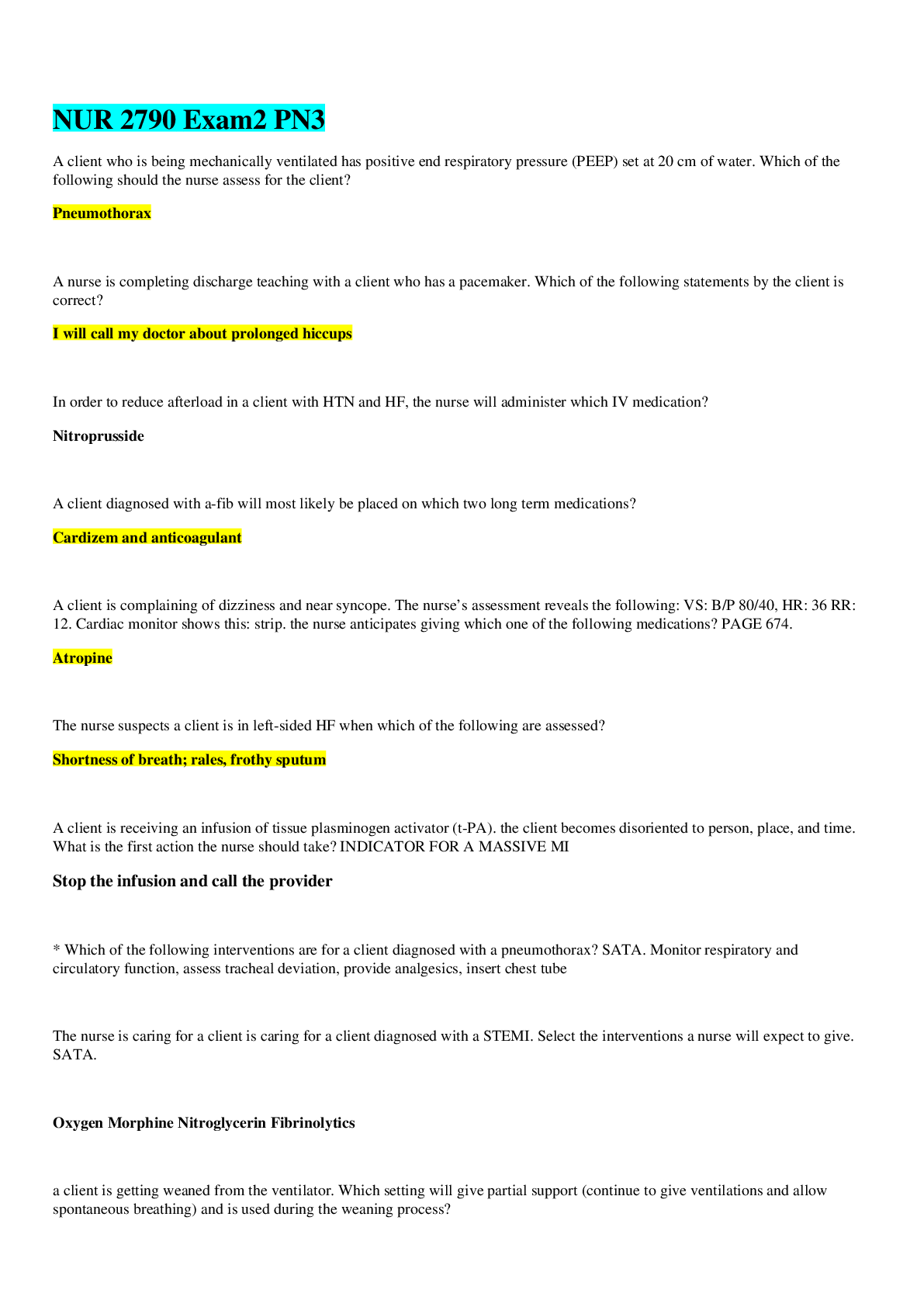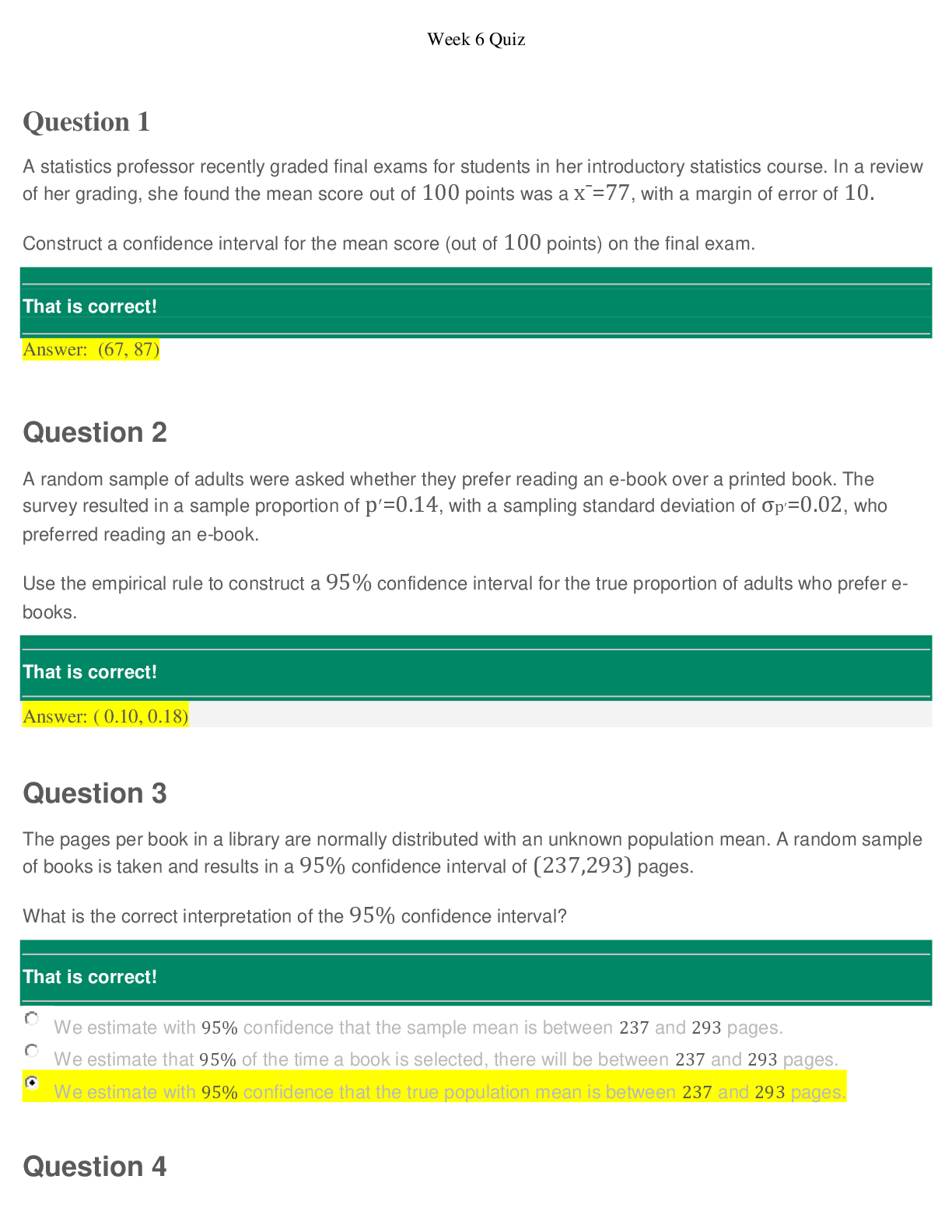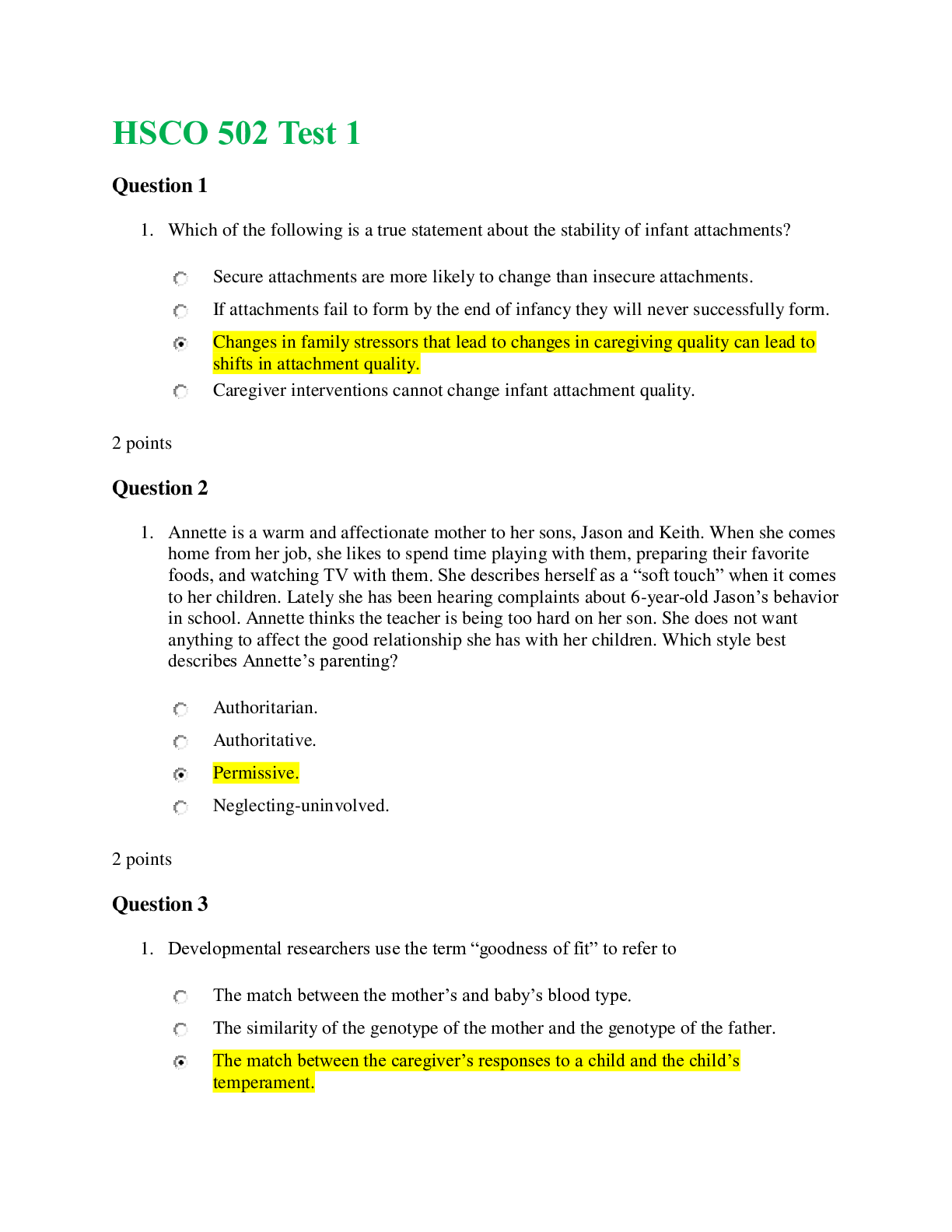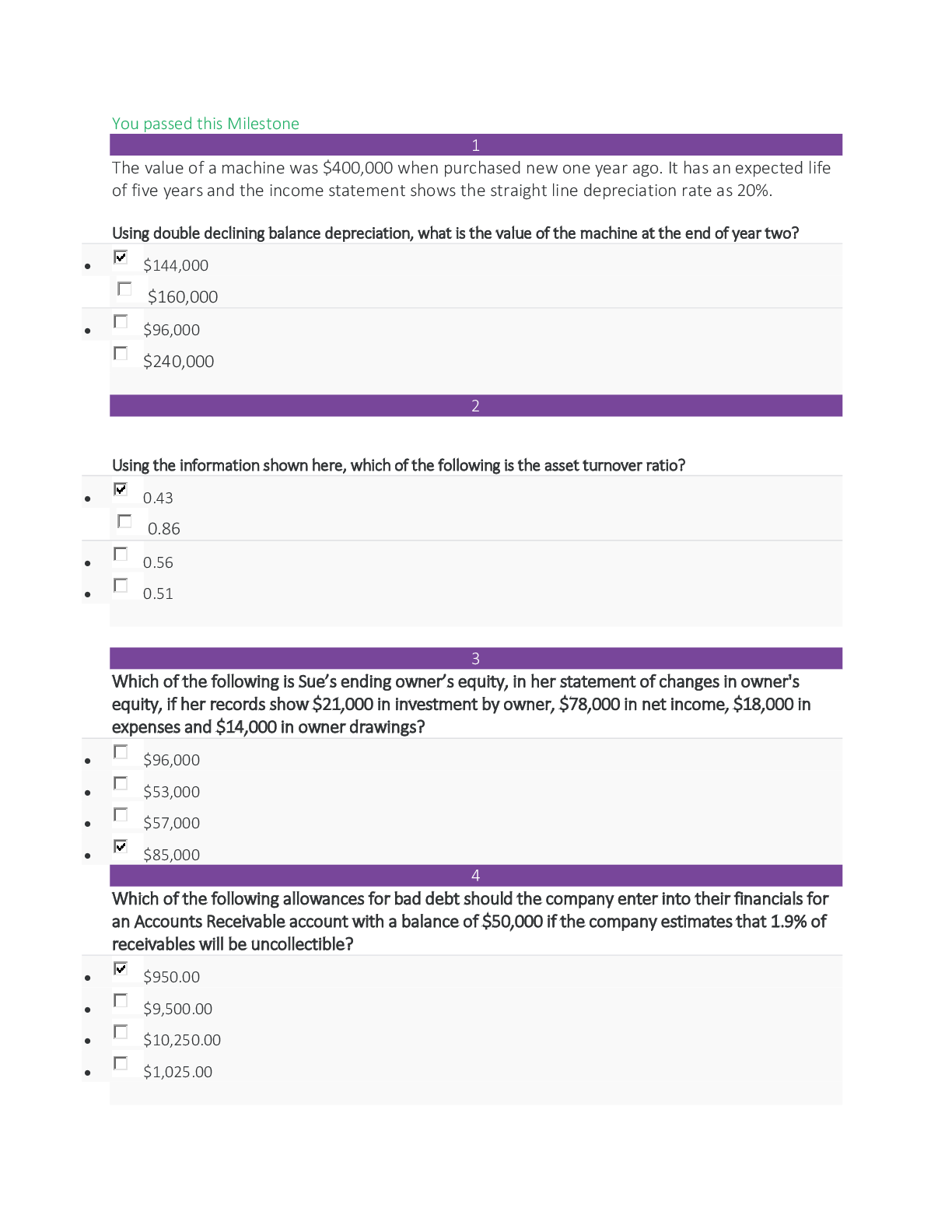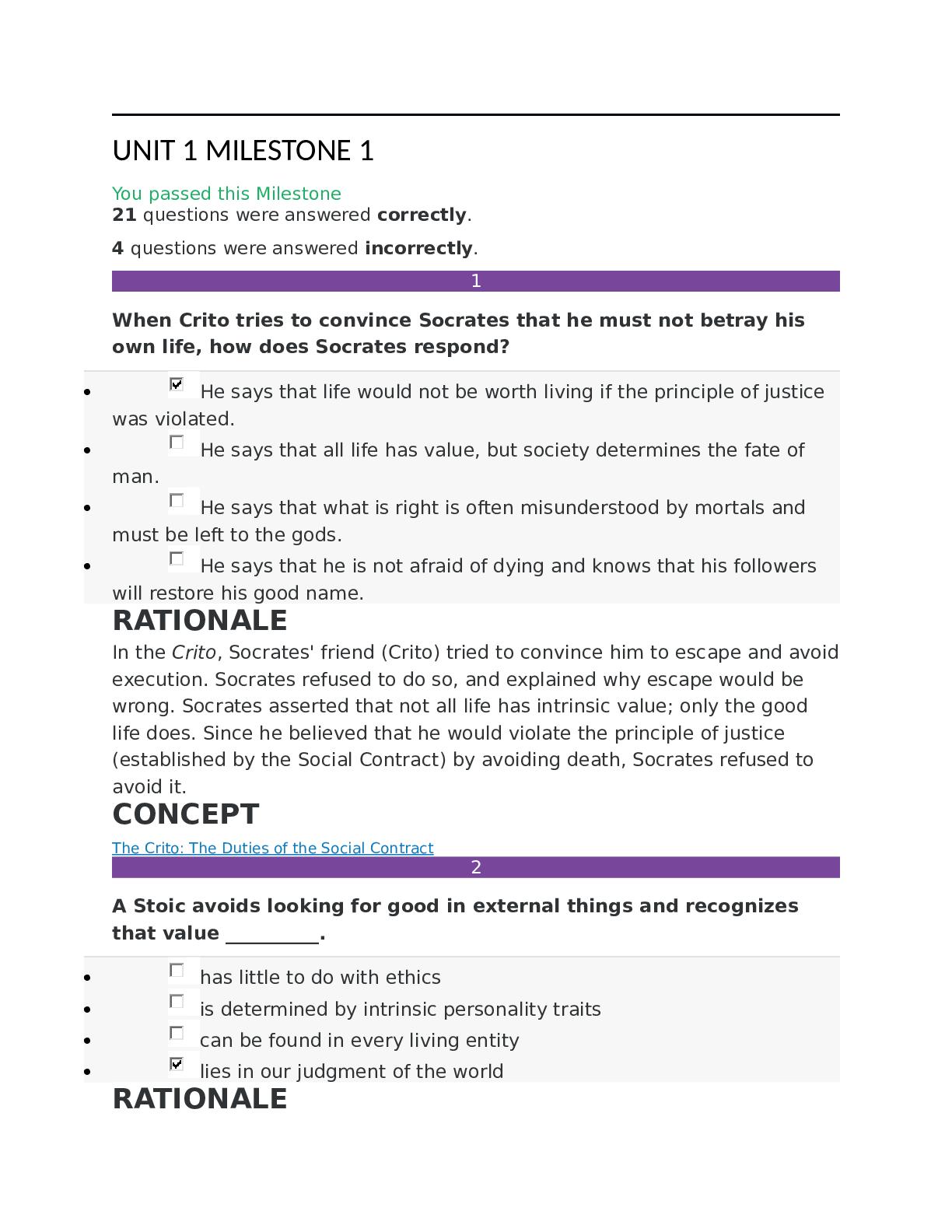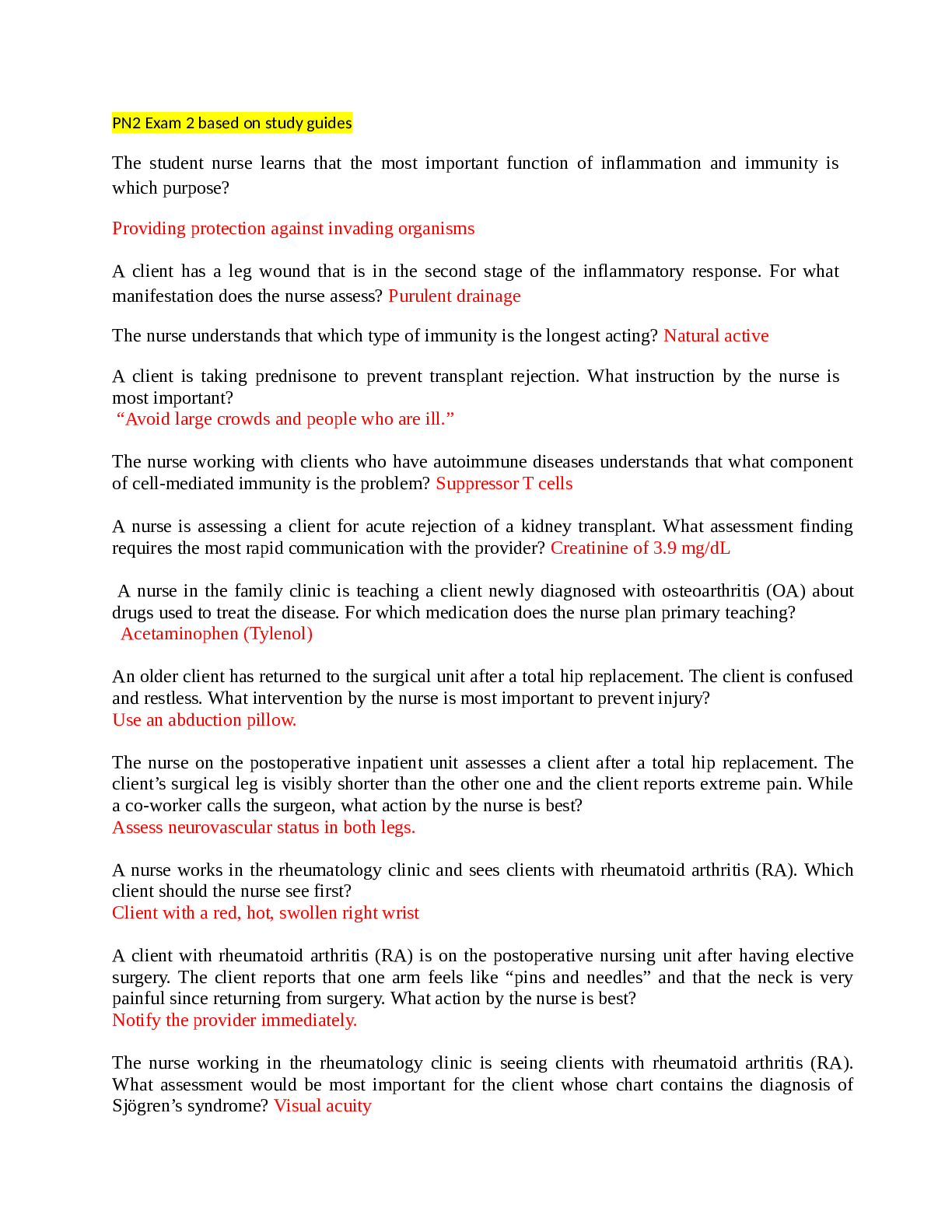*NURSING > EXAM > South University - NSG 4028/ NSG4028 Quizzes, Answers Correct (Verified) Latest Quizzes Complete Sol (All)
South University - NSG 4028/ NSG4028 Quizzes, Answers Correct (Verified) Latest Quizzes Complete Solution.
Document Content and Description Below
NSG 4028 Quizzes Question 1: Barriers to teaching can be best described as factors that negatively impact on the learner's efforts to establish a mutual partnership with the nurse educator. ... interfere with the learner's ability to attend to and process information. impede the nurse's ability to deliver educational services to the learner. limit the nurse's focus to conducting only formal, intended teaching and learning encounters. Question 2. Question : Which are two ways to decrease a behavior or response? Avoidance conditioning and escape conditioning Punishment and nonreinforcement Positive reinforcement and punishment Punishment and escape conditioning Question 3. Question : The foremost challenge for nurses is to demonstrate: a definite link between education and positive behavioral outcomes in the learner competence in their teaching sills accurately documenting teaching to meet accreditation standards the ability to create a positive learning environment Question 4. Question : Which best defines the term teachable moment? The moment when the nurse feels educationally prepared to teach. the patient views new and different situations as challenges rather than defeats. illness suddenly forces an individual to take a less active role in his or her care. an informed patient complies with medical treatment plans. Question 5. Question : Barriers to teaching differ from obstacles to learning in that obstacles to learning: are barriers that impede the nurses ability to provide education are barriers that prevent the learner from paying attention are psychosocial issues presented by the learner include lack of time for the nurse to teach Question 6. Question : Learning that is directed by the individual learner where information is received, interpreted and reorganized is known as: information processing cognitive learning discrimination learning stimulus generalization Question 7. Question : The major contribution of QSEN is to develop competencies related to patient education and safety an educational program for undergraduate nursing students staff development guidelines for patient safety programs to change the attitudes of nurses related to patient education Question 8. Question : Which learning theory is described by the idea to change behavior, change a person's subjective feelings about the self. Psychodynamic humanistic behaviorist cognitive Question 9. Question : The broad purposes, benefits, and goals of the teaching-learning process are to predetermine client outcomes to accomplish the goals of care. to improve the efficiency and effectiveness of practice. to ensure client/family compliance with therapeutic regimens. to increase the competence and confidence of the learner. Question 10. Question : With which learning theory individuals to be motivated, individuals need to be in a state of deprivation; there needs to be something that they want. Thus, giving children everything they want when they want it may undermine their motivation to perform humanistic psychodynamic cognitive behaviorist Question 11. Question : Which learning theory is described by the idea to change behavior, change the stimulus conditions in the environment and a person's responses to the environment? Psychodynamic humanistic behaviorist cognitive Question 12. Question : Which of the following actions would not enhance the permanence of learning? utilizing the new skill reinforcing the information the nurse is called away during the teaching relate previous experiences to the learner Question 13. Question : Which learning theory represents a combination of behaviorist and cognitive principles of learning? Gestalt Developmental Attribution Social learning Question 14. Question : Which learning theory is described by the idea to change behavior, change a person's perceptions and thoughts? Psychodynamic humanistic behaviorist cognitive Question 15. Question : When comparing nursing process and education process, the education process focuses on: the physical and psychosocial needs of patients changing knowledge, skills, attitudes and values (p. 11) quality outcomes meeting patient needs Question 16. Question : The primary role of the educator is to: teach create partnerships with learners promote learning in environments conducive to learning (p.13) meet accreditation and legal mandates related to patient teaching Question 17. Question : Which statement concerning nurses as educators is false? It is predicted that the growth of managed care will impact negatively on the nurse's responsibility for health education of clients. During the past few decades, client and staff teaching have begun to be recognized as independent nursing functions. Nurses must be prepared to teach colleagues, staff and students effectively. The role of the nurse as educator has changed from a disease-oriented approach to a health-promotion approach Question 18. Question : When learning a new motor skill, the learner completes the skill and is praised by the nurse. This type of feedback is described as: intrinsic extrinsic follow-up outcome Question 19. Question : What is the single most important goal of the nurse as educator? To prepare the client for self-care management To determine the trends in the delivery of high-quality care To understand the forces affecting nurses' responsibilities in practice To maintain the client's sense of value and self-worth Question 20. Question : Which of the following is not a perspective within cognitive theory? Systematic desensitization Social constructivism Information-processing Developmental Question : Which principle is not applicable to adult learning? Learning is self-controlled and self-directed. Learning is person-centered and problem-centered. The nature of learning activities remains stable over time. Learning is reinforced by application and prompt feedback. Question 2. Question : The nurse demonstrates to a client how to change a dressing. During the return demonstration the nurse should include which intervention? Question the client about the procedure. Offer the client cues when necessary. Explain each step as the client does it. Reduce the client's anxiety with casual conversation. Question 3. Question : What is the purpose of writing clear and concise behavioral objectives? To specify what the teacher is expected to teach To specify what the learner is expected to be able to do To keep the learner motivated To allow the learner to achieve many possible outcomes Question 4. Question : Which is the most significant guideline to consider when selecting audiovisual aids? Computer-assisted technology will be the more effective way to convey messages to the learner in the future. Materials of all types should be previewed for accuracy and appropriateness of content and delivery. Purchasing the best equipment available will ensure currency information for the longest period of time. The suitability of a medium depends on its diversity in communicating information. Question 5. Question : Who is the noted expert in defining the key milestones of psychosocial development? Erikson Havighurst Knowles Piaget Question 6. Question : What should be included in the performance characteristic of a well-written behavioral objective? The testing situation or constraints under which the learner's behavior will be observed With what accuracy, or to what extent, the learner will be able to carry out the behavior Who will do the learning, such as the patient, family member, or significant other What behavior the learner is expected to be able to do to demonstrate evidence of achievement Question 7. Question : Which statement is false regarding the cognitive, affective, and psychomotor domains of learning? Each domain is ordered in a taxonomic form of hierarchy from a series of simple to complex behaviors. The cognitive, affective, and psychomotor domains are separate and unrelated, reflecting the development of skills, thinking, and feeling capabilities, respectively. The cognitive and psychomotor domains represent the degree of understanding and skill attainment while the affective domain represents the degree of internalization and commitment to a feeling. The learner must be successful at demonstrating behaviors at the lower levels of any domain before being able to achieve behaviors at the higher levels in that domain. Question 8. Question : Which of the following statements is false with respect to the characteristics of goals and objectives? A goal is multidimensional and long-term. An objective describes the specific performance a learner must exhibit to be considered competent. An objective is unidimensional and short-term. A goal is the intended result of instruction that is derived from the stated objectives. Question 9. Question : A nurse educator is conducting a learning needs assessment prior to teaching a group. Which is the best method to collect information quickly while safeguarding individual privacy? Structured interviews Focus groups Questionnaires Observations Question 10. Question : Which of the following is mandated by The Joint Commission? Teaching plans must address stage-specific competencies of the learner. Families must decide whether to participate in patient education prior to patient discharge. The client is required to initiate education about his or her diagnosis. The nurse must provide patient education in written form. Question 11. Question : How does anxiety affect emotional readiness to learn? As the level of anxiety increases, emotional readiness peaks and then begins to decrease. The optimal time for learning is when a person experiences a low level of anxiety. A person is most ready to learn when his or her anxiety is on either end of the continuum, either mild or severe. Moderate anxiety interferes with a person's readiness to learn. Question 12. Question : Educators provide the best teaching when: educators avoid using only teaching methods that match their own learning style. learning activities reinforce the teachers learning style only one learning style is used by the educator the educator stimulates learners to utilize new learning styles Question 13. Question : Which is a common argument by educators against the use of behavioral objectives for teaching and learning? Written objectives tailor teaching only to the learner's particular circumstances and needs. Careful construction of objectives directs educators to keep their teaching targeted and learner-centered. Predetermined objectives force teachers and learners to attend only to specific objectives, thereby stifling creativity and freedom in teaching and learning. Mutual decision making in establishing objectives requires effort on the part of both the teacher and the learner. Question 14. Question : All of the following statements are true about learning styles except: Leaning style theory assists the nurse educator to ensure that each individual learner is given an equal opportunity to learn. Nurse educators tend to prefer abstract and unstructured approaches to teaching. No single mode describes someone's learning style, because each person is unique and comes with other factors that are equally important in learning. Preference for a particular style of learning tends to change very little over time. Question 15. Question : The most important criterion in evaluating an instructional method is to determine whether the method: facilitates the achievement of objectives. uses resources efficiently. promotes active learning. is enjoyed by learners. Question 16. Question : Which guideline should the educator follow when selecting instructional materials? The goal for learning should be set before materials are selected. The choice of materials should give direction in the establishment of objectives for learning. The selection of appropriate materials should assist the educator in determining the domains of learning on which to focus instruction. The audiovisual tools available should guide the educator's decision making regarding the content for instruction. Question 17. Question : Learning needs can best be defined as gaps in knowledge that exists between a desired level of performance and the actual level of performance. the manner by which an individual perceives and processes information. an outcome by which learners demonstrate more confidence in what they are expected to do. an interest and an ability in learning the type and degree of information or skills necessary to maintain optimal health. Question 18. Question : The nurse educator is preparing a class for a group of middle-aged adults. Based on the developmental stage of this group, which topic should the nurse select for this class to meet the immediate needs of these learners? Accident prevention Stress reduction Chronic illness management Treatment of acute illnesses Question 19. Question : Which is not part of the instructor's role when using gaming as an instructional method? Explain the objectives and rules for the players. Intervene during the game to explain concepts. Award prizes to winners at the finish. Debrief players after the game. Question 20. Question : Which method is best to accomplish objectives in the psychomotor domain? Computer-assisted instruction Group discussion Role-modeling Simulation [Show More]
Last updated: 1 year ago
Preview 1 out of 13 pages
Instant download

Buy this document to get the full access instantly
Instant Download Access after purchase
Add to cartInstant download
Reviews( 0 )
Document information
Connected school, study & course
About the document
Uploaded On
Jan 21, 2020
Number of pages
13
Written in
Additional information
This document has been written for:
Uploaded
Jan 21, 2020
Downloads
0
Views
42



